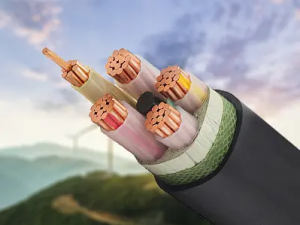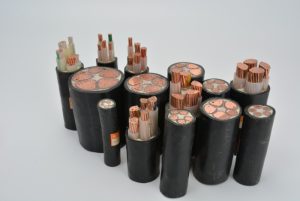With the development of society, the requirements of wire and cable are also increasing, the classification of wire and cable is more and more detailed, such as fire-resistant, flame retardant, and LSZH cable also appearing in our daily life.
LSZH Cable is what cable?
Low smoke, as the name implies, reduces the production of harmful objects when the cable is burning.
Halogen is a toxic gas for the human body, halogen-free is no toxic gas release, usually for the cable in case of fire.
Low-smoke halogen-free power cables can also be called environmentally friendly cables, most of them are used in hospitals and places with strict requirements for environmental health.
The halogen-containing flame retardant cable insulation, sheath, outer sheath, and auxiliary materials wrap and fill all or part of the halogen-containing polyethylene PVC flame retardant materials, and thus has good flame retardant properties.
But in the cable, burning will release a lot of smoke and halogen acid gas, halogen acid gas on the surrounding electrical equipment has corrosive hazards, and rescue personnel needs to put on gas masks to approach the scene to put out the fire.
So for these wires and cables and how to identify them. Well, the following ZMS cable editor to the big guys about the identification of low smoke halogen-free wire and cable method!

It can be identified by the following aspects.
Product Name Identification Method
Wire – low smoke halogen-free flame retardant polyethylene insulated wire and cable
Cable – polyethylene insulation LSZH flame retardant sheathing power cable
Imitation products will generally have a little different name, such as polyethylene insulation low smoke halogen-free sheathed flame retardant power cable, and so on.
LSZH Cable Skin Burning Method
1 With a soldering iron to burn the insulation layer generally will not have a significant dent, if there is a larger dent indicating that the insulation layer using materials or process defects.
2 Or barbecue with a lighter, under normal circumstances, should not be easy to ignite.
Even if burning, after a long time burning cable insulation layer is still relatively intact, with no smoke and irritating odor, while the diameter has increased.
3 If it is easy to ignite, it can be determined that the cable’s insulation layer does not use LSZH cable materials, most likely polyethylene or cross-linked polyethylene materials.
4 If there is a large smoke, it means that the insulation layer is using halogen-containing materials.
If the insulation surface peels off severely after a long period of combustion and the diameter does not increase significantly, it means that no suitable irradiation cross-linking process has been carried out.
Hot Water Immersion Method
Soak the core or cable in hot water at 90 °C. Under normal circumstances, the insulation resistance will not drop rapidly and remain above 0.1 MΩ/Km.
If the insulation resistance drops sharply or even below 0.009 MΩ/Km, it means that it has not been processed by suitable irradiation cross-linking process.
Note: Polyethylene or cross-linked polyethylene insulation materials do not apply to this method of identification, and can be identified by the method in the second article above.
Density Comparison Method
Low-smoke halogen-free materials are denser than water, you can peel off a little insulation layer into the water, if it floats above the water’s surface, it is not low-smoke halogen-free material.
The difference with ordinary cable
Low smoke and the halogen-free cable may be burned and not operate in case of fire, but it can stop the spread of fire.
In layman’s terms, in the event of a cable fire, it can limit the burning to a localized area and not produce a spread, preserving various other equipment and avoiding greater damage.
According to the different flame retardant materials of cables, flame retardant cables are divided into two categories: halogen-containing flame retardant cables and halogen-free low-smoke flame retardant cables.
Definition of environmentally friendly cables
Environmentally friendly cables are cables that do not produce toxic and harmful substances before and after use and during use, such as heavy metals like lead, cadmium, hexavalent chromium, mercury, etc., do not contain brominated flame retardants, and are tested by SGS recognized testing organizations for environmental performance, and meet the EU environmental directives and are higher than their index requirements.
No harmful halogen gas, no corrosive gas, low combustion fever, no soil pollution wire, and cable.

What is the application of LSZH cable?
Application of low-smoke halogen-free cable products is mainly concentrated in the field of large-scale projects, and high-tech fields.
For example, railroads, subways, automobiles, etc. China in the construction of railroad networks, traction cables, signal cables, control cables, etc. used low smoke halogen-free products to protect passenger safety.
The new subway projects in various places are no exception, all using LSZH products.
The automotive field has also begun to recognize the importance of low-smoke halogen-free products, and most of the wiring uses LSZH cable.
In daily life, the low-smoke halogen-free cable is widely used in nuclear power plants, subway stations, telephone exchanges and computer control centers, high-rise buildings, hotels, radio and television stations, important military facilities, and oil platforms, as well as more concentrated places and low air density.
To improve the safety of the circuits in your home, the ZMS cable manufacturer recommends that you use low smoke and halogen-free flame retardant cables as your home wiring.
ZMS cable consistently uses high-purity oxygen-free copper as the core to eliminate the occurrence of overload, while using self-developed environmentally friendly materials as insulation, greatly reducing the risk of leakage and short circuit, bringing multiple protections for your family, so that the cable is in line with national standards to truly protect our lives.
Do not hold a fluke mentality, once the accident is, too late to regret!